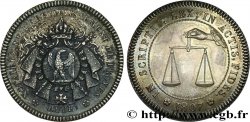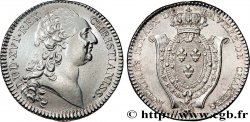fjt_769314 - NOTAIRES ROYAUX Notaires de Lyon 1715
无库存.
所有在网站上销售的产品 (2022)
价格 : 40.00 €
所有在网站上销售的产品 (2022)
价格 : 40.00 €
种类 Notaires de Lyon
日期: 1715
材质 silver
直径 30 mm
模子方针 6 h.
重量 8,63 g.
侧面 striée
关于品相的说明
Légères marques de manipulation, un très bel exemplaire
出版目录中的项代码 :
正面
正面的文字 MES LES CONSERS DU ROY. NOTAIRES. DE LION.
正面的说明书 Armes de France couronnées encadrées de deux anges et au-dessus d'un lion couché à gauche.
背面
背面的文字 LEX. EST. QVODCVMQ. NOTAMVS..
背面的说明书 Le gnomon sur une console, au-dessous 1715.
背面的翻译 (Est Loi ce que nous consignons).
评论
Les notaires royaux étaient institués près des justices royales. Ils ne pouvaient instrumenter hors du ressort de celle auprès de laquelle ils étaient établis à l'exception des notaires au Châtelet qui avaient le privilège de pouvoir le faire dans toute la France. Comme officiers publics, ils étaient chargés de dresser les actes et contrats auxquels les parties veulent donner un caractère d'authenticité. En 1597, les tabellions, chargés de garder les minutes et de délivrer des grosses, deviennent des notaires garde notes et garde scel mais ils se confondent rapidement avec les notaires chargés de recevoir. L'édit de juillet 1682 exigeait profession de la religion catholique, attestation de bonne vie et mœurs par le curé et un examen pour être reçu notaire.
Royal notaries were established near the royal courts. They could not act outside the jurisdiction of the court in which they were established, with the exception of the notaries at the Châtelet who had the privilege of being able to do so throughout France. As public officers, they were responsible for drawing up deeds and contracts to which the parties wished to give a character of authenticity. In 1597, the tabellions, responsible for keeping the minutes and issuing gross documents, became notaries keeping notes and keeping seals, but they quickly merged with the notaries responsible for receiving documents. The edict of July 1682 required profession of the Catholic religion, attestation of good conduct and morals by the priest and an examination to be admitted as a notary
Royal notaries were established near the royal courts. They could not act outside the jurisdiction of the court in which they were established, with the exception of the notaries at the Châtelet who had the privilege of being able to do so throughout France. As public officers, they were responsible for drawing up deeds and contracts to which the parties wished to give a character of authenticity. In 1597, the tabellions, responsible for keeping the minutes and issuing gross documents, became notaries keeping notes and keeping seals, but they quickly merged with the notaries responsible for receiving documents. The edict of July 1682 required profession of the Catholic religion, attestation of good conduct and morals by the priest and an examination to be admitted as a notary








 对产品描述纠错
对产品描述纠错 打印
打印 分享我的选择
分享我的选择 提问
提问 Consign / sell
Consign / sell
 产品介绍
产品介绍









